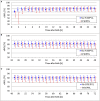Cerebral Oxygenation in Preterm Infants Developing Cerebral Lesions
- PMID: 35498781
- PMCID: PMC9039301
- DOI: 10.3389/fped.2022.809248
Cerebral Oxygenation in Preterm Infants Developing Cerebral Lesions
Abstract
Background: We investigated the association between cerebral tissue oxygen saturation (cStO2) measured by near-infrared spectroscopy (NIRS) and cerebral lesions including intraventricular hemorrhage (IVH) and periventricular leukomalacia (PVL).
Methods: Preterm infants <1,500 g received continuous cStO2 monitoring, initiated at the earliest time possible and recorded until 72 h of life. Mean cStO2 over periods of 5, 15, 30 min and 1 h were calculated. To calculate the burden of cerebral hypoxia, we defined a moving threshold based on the 10th percentile of cStO2 of healthy study participants and calculated the area under the threshold (AUT). cStO2 <60% for >5 min was regarded a critical event. The study was registered on clinicaltrials.gov (ID NCT01430728, URL: https://clinicaltrials.gov/ct2/show/NCT01430728?id=NCT01430728&draw=2&rank=1).
Results: Of 162 infants (gestational age: mean 27.2 weeks, standard deviation 20 days; birth weight: mean 852 g, standard deviation 312 g) recorded, 24/12 (14.8%/7.4) developed any/severe IVH/PVL. Mean cStO2 was significantly lower in infants with IVH/PVL as well as severe IVH/PVL. In addition, we observed critical events defined by mean cStO2 over 5 min <60% in four infants with severe IVH/PVL during NIRS monitoring. AUT showed no statistically significant difference between outcome groups.
Conclusion: These findings suggest that cStO2 is lower in infants developing IVH/PVL. This may be related to lower oxygenation and/or perfusion and implies that cStO2 could potentially serve as an indicator of imminent cerebral lesions.
Keywords: cStO2; cerebral ischemia; cerebral oxygenation; intraventricular hemorrhage (IVH); near-infrared spectroscopy (NIRS); periventricular leukomalacia (PVL); preterm infant.
Copyright © 2022 Schwab, Mayer, Bassler, Hummler, Fuchs and Bryant.
Conflict of interest statement
The authors declare that the research was conducted in the absence of any commercial or financial relationships that could be construed as a potential conflict of interest.
Figures






References
-
- IQTIG, – Institut für Qualitätssicherung und Transparenz im Gesundheitswesen . Qualitätsreport 2015. Perinatalmedizin. Available online at: https://iqtig.org/downloads/berichte/2015/IQTIG-Qualitaetsreport-2015.pdf (accessed October 10, 2020).
-
- Volpe JJ. Intracranial hemorrhage: germinal matrix-intraventricular hemorrhage of the premature infant. In: Volpe J, editor. Neurology of the Newborn. Philadelphia: Saunders Elsevier; (2008). p. 517–37. 10.1016/B978-1-4160-3995-2.10011-1 - DOI
Associated data
LinkOut - more resources
Full Text Sources
Medical

